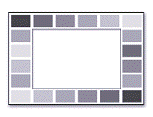Earth Science Week Classroom Activities
No Child Left Inside Activity
Sky and Cloud Windows
Grade Level: K-8 Earth Science and Art
Activity Source: The Weather Channel. Adapted with permission.
Background
Is today sunny or overcast? Is there wind, rain, or snow? No matter where you live, weather shapes your life. What’s happening in the sky can determine how you dress, what you eat, where you spend your time, and when you work—or play.
The science of the sky encompasses Earth and space science (from the solar system to the water cycle), physical science (from heat and energy to motion and forces), and science in personal and social perspectives (from the environment to global climate change).
In this activity, students will conduct experiments or participate in demonstrations to answer questions about sky and weather phenomena. Students also will analyze and present data.
Materials
- 8 1/2” x 11” poster board
- Paint chips of a variety of sky colors
- Safety scissors and glue
- Notebook and pen
- Digital camera and printer (optional)
Procedure
-
Fold the poster board in half lengthwise and cut out a center rectangle, leaving about a 2-inch frame.
-
Cut apart paint chips in shades of dark to light blue and white to dark gray. Glue these chips around both sides of the frame (see illustration).
-
Go outside for “Sky Checks.” Use the frames as references when you look up at the sky. (Remember: Always look away from the sun!) These sky and cloud windows will focus your sky observations and help you determine and keep track of sky and cloud colors and changes.
-
Every time you do a Sky Check, write down your observations in your notebook. Be sure to include the date and time for each Sky Check, the amount of cloud cover, the types of clouds, amount of wind, and any precipitation.
-
If you have a digital camera, you can take a picture of the sky through your frame. Download these onto your computer and be sure to put the date and time when you took each picture. Taking pictures is just another way of collecting and recording your sky observations.

Standards and Connections
NGSS
- Disciplinary Core Ideas: ESS2.D: Weather and climate
- Science and Engineering Practices: Obtaining, evaluating, and communicating information; Planning and Carrying Out Investigations
- Crosscutting Concepts: Patterns
Sustainability Connections
- SDG 13: Climate action Observing local weather contributes to understanding climate patterns.
Related activities from NEEF, sponsor of No Child Left Inside Day
- Droughts, Floods, and Water Vapor - Oh My!
- Extend student observations of clouds to discuss how the availability of water vapor in the atmosphere not only contributes to cloud formation, but also affects weather and climate patterns.
- Use real-world data to expand students’ observations of patterns to other areas of the Earth.

